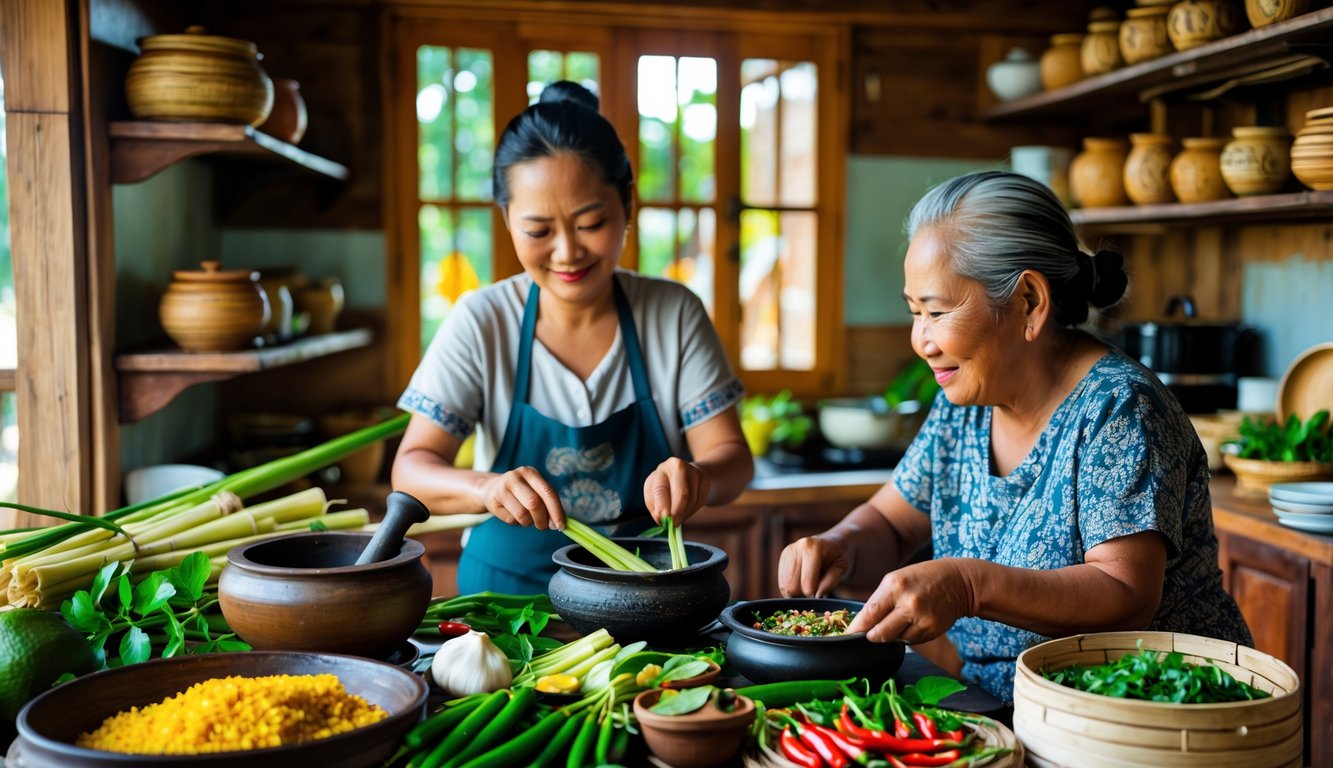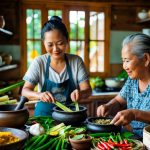
Modern Interpretations and Their Respect for Tradition
Most days I’m just trying to keep up: restaurant menus brag about “grandma’s curry” with substitutions that would make any grandma roll her eyes, while somewhere, for no reason, you’ll get pad krapow that’s weirdly sweet. Turns out, keeping real Thai flavors alive is a mess—easy Thai recipes go viral but never mention the fish sauce stains that ruin your shirt.
Thai Restaurant Adaptations
Ever notice how every Thai place in town screams “authentic Thai food” on the menu, but then you ask for real heat and they look at you like you’ve threatened their insurance rates? I mean, I get it—most folks here can’t handle bird’s eye chilies without breaking into a sweat, but still. I watched a Bangkok street vendor straight-up scowl at a tourist for asking to skip garlic. Hilarious. Then, back in the US, “mild” tom yum arrives and where’s the lemongrass? Gone. But the Thai Restaurants Association (2023) claims it’s still the #2 “real flavors” bestseller. Is that even possible? Who’s voting on these lists?
I called Chef Mayura in Chiang Mai once. She didn’t sugarcoat anything: “Pad Thai with ketchup isn’t Pad Thai, it’s school lunch.” She’s not wrong, but American kitchens keep doing it. Som tam, massaman curry, laab—they all get softened up for whatever diet trend is hot or because someone’s scared of sodium. But honestly, the only places I trust are the ones where the owner’s too stubborn to change anything, even if tourists leave angry reviews about “too much spice.” That’s commitment. Or maybe just spite.
And ingredients—don’t get me started. If a recipe says “herb kit” or powdered lime leaves, just close the tab. I’ve broken two mortar-and-pestles trying to get that right texture. There’s nothing easy about it, and I kind of hate anyone who says otherwise.
Bringing Untouched Recipes Abroad
Dragging “untouched” Thai recipes out of Thailand? Good luck. Maybe if your luggage reeks of fermented fish sauce and nobody at customs has a nose. I tried sneaking prik kee noo into Sydney once—almost lost my lunch at the airport, but whatever, worth it for the heat. Real talk: Thai families abroad are hoarding their handwritten cookbooks like gold, but outside Thailand, ingredients cost a fortune or taste…off. I mean, why does imported galangal taste like wood chips?
Thai expat supper clubs get it. My friend Nit in Toronto refuses to use brown sugar in gaeng pa—only the real palm stuff, even if it means a thirty-minute subway ride. Bangkok University had a study last year: 70% of Thais abroad swap at least one key ingredient. When they don’t, those recipes turn into unicorns—everyone wants them, nobody can find them. And no one’s talking about how galangal tastes like nothing after two weeks in a shipping crate. Why is that?
Every time I stumble across real gaeng som or sai ua at a food festival—no sriracha, no “fusion”—I drag my friends over. I dare them to spot missing fish sauce. They never do. They just sweat buckets and complain, which, honestly, is the best authenticity test I’ve found. But who actually wants a menu that makes you sweat through your shirt?
Frequently Asked Questions
So apparently, my neighbor’s aunt—who literally refuses to write down recipes—keeps coming up in these conversations about what “untouched” food even means. Chicken rice so potent it takes over the whole house, fish sauce everywhere, battered pots that look older than me. No one’s switching to Dutch ovens, either. And I still can’t figure out why their coconut milk tastes nothing like the stuff I buy at Tesco Lotus. Are they hiding secret brands?
What classic Thai dish do locals recommend for a true taste of their cuisine?
Pad krapow with holy basil. Not that random Italian basil—real holy basil. I see it everywhere. Sometimes it’s cooked in woks that look like they survived a war, and nobody swaps the basil unless they’re desperate. Nattaya, who’s run a stall in Bang Rak for 19 years, told me, “If you can’t find holy basil, cook something else.” Kind of harsh, but fair.
But is tom yum a fallback? Everyone serves it, but if the lemongrass is sad, nobody bothers. My old cooking teacher used to snap garlic cloves in half to check freshness. I’m not making that up.
How does traditional Thai street food differ from what’s served in restaurants?
Honestly, I get Pad Thai from a stand near Victory Monument—dodging mopeds, breathing in exhaust, chili everywhere, lime, nothing sanitized. Crunchy, sharp, seeds everywhere. Then I go inside a shiny restaurant, and the same dish is bland, no raw garlic, maybe two tiny dried shrimp. Why bother?
There’s this thing—street cooks actually use their wrists, flinging the pan around like they’re mad. I tried it once. Disaster. The curbside stuff is always saltier, spicier, and somehow cheaper. Menu’s tiny, flavors are intense, and you get way more basil than you wanted. Not that I’m complaining.
What are the essentials of making an authentic Thai soup at home?
Forget makrut lime leaves one time and my Thai friends basically ghost me. Soup depends on them and galangal. No pre-made nam prik paste allowed, not at my neighbor’s, anyway. She still pounds everything with a stone mortar, sweating over the kitchen tile.
And coconut milk—don’t just dump the can in. You have to tip off the watery part and keep the thick stuff. Cut corners and your tom kha tastes like regret. Suriya, who always lectures me about using chicken necks instead of boneless breast, makes me feel lazy every time I try shortcuts.
Can you describe a typical Thai main course that has remained unaltered by modern cooking trends?
Khao man gai is everywhere, but it’s stubbornly untrendy. Westerners expect sweet sauces or fancy rice, but nope—just boiled chicken, coriander root, garlic smashed with a knife, and if you use sticky rice, you’re wrong. That’s it.
Nobody’s getting creative with garnishes, either. Still cucumber slices, a cup of broth, and that MSG-heavy chili-ginger sauce I first tried in 2014 at some Chinatown hole-in-the-wall. Even the plates are still that weird pale blue, all scratched up.
Which herbs and spices are indispensable in original Thai cooking?
Gaprao (holy basil), fresh bird’s eye chili, lemongrass you can snap, coriander root, galangal fat as your thumb, kaffir lime leaves—none of that dried or jarred stuff. Samsorn, a chef with more scars than I have fingers, always says, “No skipping the roots. Don’t even try curry paste from a packet.”
I did once, and my green curry tasted like airplane food. Turmeric stains everything, but the real color only comes from the root, not powder. Learned that the hard way.
What techniques do Thai home cooks use to preserve the authenticity of their traditional recipes?
Look, I’ll never understand how my aunt manages to bruise chilies with a stone mortar while yelling at the TV and somehow nails the flavor every time. She swears by peanut oil—won’t touch canola, says it’s “just not right.” Measuring spoons? Not a single one in her kitchen. She just grabs a pinch, tastes, shrugs, maybe adds more until, I don’t know, your nose sweats? That’s apparently the goal.
And then there’s my friend who moved to Malmö, still obsessed with her own brand of fish sauce. She literally mails it to herself because, in her words, “Swedish stuff tastes like sadness.” I tried using a blender once—big mistake. She gave me a look like I’d microwaved a banana leaf. Everyone’s always pounding things by hand, acting like it’s a moral obligation. I keep asking how they get the rice sticky without burning it or setting a timer, but nobody gives a straight answer. Maybe it’s a family secret. Or maybe nobody actually knows and they’re all just winging it.



